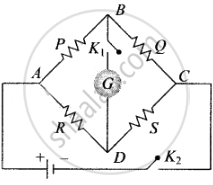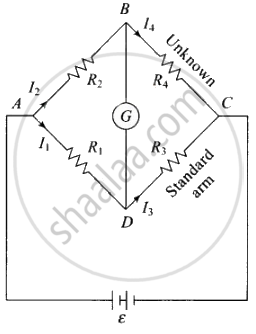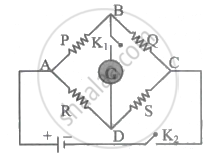Advertisements
Advertisements
प्रश्न
The measurement of an unknown resistance R is to be carried out using Wheatstones bridge (figure). Two students perform an experiment in two ways. The first students takes R2 = 10 Ω and R1 = 5 Ω. The other student takes R2 = 1000 Ω and R1 = 500 Ω. In the standard arm, both take R3 = 5 Ω. Both find R = `R_2/R_1 R_3` = 10 Ω within errors.
- The errors of measurement of the two students are the same.
- Errors of measurement do depend on the accuracy with which R2 and R1 can be measured.
- If the student uses large values of R2 and R1, the currents through the arms will be feeble. This will make determination of null point accurately more difficult.
- Wheatstone bridge is a very accurate instrument and has no errors of measurement.
विकल्प
a and b
b and c
c and d
a and d
उत्तर
b and c
Explanation:
Wheatstone bridge: The bridge is an arrangement of four resistance which can be used to measure one of them in terms of rest. Here arms AB and BC are called ratio arm and arms AC and BD are called conjugate arms.

Balanced bridge: The bridge is said to be balanced when deflection in the galvanometer is zero, i.e. no current flows through the galvanometer or in other words VB = VD. In the balanced condition `P/Q = R/S`, on mutually changing the position of cell and galvanometer this condition will not change.
Unbalanced bridge: If the bridge is not balanced current will flow from D to B if VD > VB, i.e. (VA – VD) < (VA – VB) which gives PS > RQ.
According to the problem for first students, R2 = 10 Ω, R1 = 5 Ω, R3 = 5 Ω
For second student, R1 = 500 Ω, R2 = 1000 Ω, R3 = 5 Ω
Let us take R4 = R.
Now, according to the Wheatstone bridge rule,
`R_2/R_1 = R_4/R_3` ⇒ `R_4 = R_3 xx R_2/R_1`
Now putting all the values in above equation, we get R = 10 Ω for both students. Thus, we can analyse that the Wheatstone bridge is most sensitive and accurate if resistances are of the same value.
Thus, the errors of measurement of the two students depend on the accuracy and sensitivity of the bridge, which in turn depends on the accuracy with which R2 and R1 can be measured.
The currents through the arms of bridge is very weak when R2 and R1 are larger.
This can make the determination of null point accurately more difficult.

APPEARS IN
संबंधित प्रश्न
Four resistances 4Ω,8Ω,XΩ, and 6Ω are connected in a series so as to form Wheatstone’s
network. If the network is balanced, find the value of ‘X’.
State any two sources of errors in the meter-bridge experiment. Explain how they can be minimized.
Two wires A and B of equal lengths are connected in left and right gap of a meter bridge, null point is obtained at 40 cm from left end. Diameters of the wire A and B are in that ratio 3 : 1. The ratio of specific resistance of A to the of B is ____________.
In a Wheatstone bridge, when the potentials at points B and D are the same, then the current through the galvanometer ______

In Wheatstone's network p = 2 `Omega` , Q = 2 `Omega`, R = 2 `Omega` and S = 3 `Omega`. The resistance with which S is to be shunted in order that the bridge may be balanced is ______.
The resistances in left and right gap of a metrebridge are 20 `Omega` and 30 `Omega` respectively. When the resistance in the left gap is reduced to half its value, the balance point shifts by ______.
When an unknown resistance 'X' is connected in the left gap of a meter bridge and a known resistance 'R' in the right gap, a null point is obtained at 40 cm from the left end. If a 2 Ω resistance is connected in series with 'X' the null point shifts towards the right by 10 cm, with some resistance in the right gap. The value of 'X' must be ______
A resistance R is to be measured using a meter bridge. Student chooses the standard resistance S to be 100Ω. He finds the null point at l1 = 2.9 cm. He is told to attempt to improve the accuracy. Which of the following is a useful way?
A resistance of 20 Ω is connected in the left gap of a meter bridge and an unknown resistance greater than 20 Ω is connected in the right gap. When these resistances are interchanged, the balance point shifts by 20 cm. The unknown resistance is ______.
Explain the use of Wheatstone's metre bridge to determine an unknown resistance.
